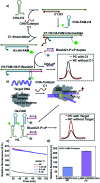Coupling nucleic acid circuitry with the CRISPR-Cas12a system for universal and signal-on detection
- PMID: 35425009
- PMCID: PMC8977996
- DOI: 10.1039/d2ra01332k
Coupling nucleic acid circuitry with the CRISPR-Cas12a system for universal and signal-on detection
Abstract
We report a universal and signal-on HCR based detection platform via innovatively coupling the CRISPR-Cas12a system with HCR. By using this CRISPR-HCR pathway, we can detect different targets by only changing the crRNA. The CRISPR-HCR platform coupling with an upstream amplifier can achieve a practical sensitivity as low as ∼aM of ASFV gene in serum.
This journal is © The Royal Society of Chemistry.
Conflict of interest statement
There are no conflicts to declare.
Figures




Similar articles
-
Hybridization chain reaction circuit controller: CRISPR/Cas12a conversion amplifier for miRNA-21 sensitive detection.Talanta. 2024 Jan 1;266(Pt 2):125130. doi: 10.1016/j.talanta.2023.125130. Epub 2023 Aug 26. Talanta. 2024. PMID: 37657377
-
High-throughput and all-solution phase African Swine Fever Virus (ASFV) detection using CRISPR-Cas12a and fluorescence based point-of-care system.Biosens Bioelectron. 2020 Apr 15;154:112068. doi: 10.1016/j.bios.2020.112068. Epub 2020 Feb 4. Biosens Bioelectron. 2020. PMID: 32056963
-
A universal CRISPR/Cas12a nucleic acid sensing platform based on proximity extension and transcription-unleashed self-supply crRNA.Anal Chim Acta. 2021 Sep 1;1176:338755. doi: 10.1016/j.aca.2021.338755. Epub 2021 Jun 14. Anal Chim Acta. 2021. PMID: 34399899
-
Development and clinical application of a novel CRISPR-Cas12a based assay for the detection of African swine fever virus.BMC Microbiol. 2020 Sep 14;20(1):282. doi: 10.1186/s12866-020-01966-6. BMC Microbiol. 2020. PMID: 32928112 Free PMC article.
-
CRISPR/Cas12a Powered DNA Framework-Supported Electrochemical Biosensing Platform for Ultrasensitive Nucleic Acid Analysis.Small Methods. 2021 Dec;5(12):e2100935. doi: 10.1002/smtd.202100935. Epub 2021 Oct 10. Small Methods. 2021. PMID: 34928030
Cited by
-
Application of Hybridization Chain Reaction/CRISPR-Cas12a for the Detection of SARS-CoV-2 Infection.Diagnostics (Basel). 2023 May 7;13(9):1644. doi: 10.3390/diagnostics13091644. Diagnostics (Basel). 2023. PMID: 37175035 Free PMC article.
References
LinkOut - more resources
Full Text Sources
Other Literature Sources

